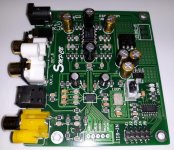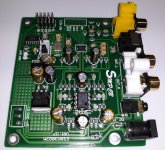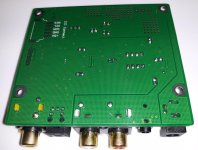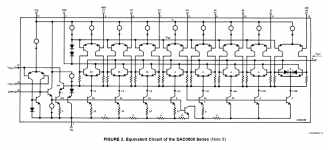So my ES9038Q2M board has arrived. (Pictures attached.) Physically it looks pretty nice but so far I am not happy with the sound of it.
After three days of listening I am a bit shocked at what I would call a fatiguing, harsh or piercing high end. I guess others might use the word "bright" but I think it is more than that. This is in comparison to my AK4396 with all other components the same in the test setup.
For now I am just using a coaxial input (same as with the AK4396) that comes from an ES6629 Vibratto-II DVD Processor inside a Philips DVD player. (Basic, but seems to work well with the AK4396 board.)
I was not expecting it to start out with this sort of sound based upon what I have heard about the ES9038Q2M. But perhaps this is a lesson for me in terms of implementation. I am using the same LM4562 in both.
My first guess (from reading this thread for a month or so) is that it is power supply implementation related. I don't see radical differences between the output sections of the two boards and I am using the same LM4562 chip in both. Since my CS4398 board has six regulators and the AK4396 has six regulators I guess I can not be shocked when this board has only two. Especially given what I have read about the AVCC having zero PSRR and it is the same cheap AMS1117-3.3 that is shared for 8(?) supply pins on the board.
I was hoping to make modifications slowly because I don't like massacred boards. But this isn't very listenable out of the box. Perhaps I try 2200uF 16V low ESR on the AVCC (solder to the 100uF 16V ELNA RA3 pins under the board) as a first quick adjustment to make it more listenable? Or use some of the 560uF or 1000uF OS-CON that I have?
After three days of listening I am a bit shocked at what I would call a fatiguing, harsh or piercing high end. I guess others might use the word "bright" but I think it is more than that. This is in comparison to my AK4396 with all other components the same in the test setup.
For now I am just using a coaxial input (same as with the AK4396) that comes from an ES6629 Vibratto-II DVD Processor inside a Philips DVD player. (Basic, but seems to work well with the AK4396 board.)
I was not expecting it to start out with this sort of sound based upon what I have heard about the ES9038Q2M. But perhaps this is a lesson for me in terms of implementation. I am using the same LM4562 in both.
My first guess (from reading this thread for a month or so) is that it is power supply implementation related. I don't see radical differences between the output sections of the two boards and I am using the same LM4562 chip in both. Since my CS4398 board has six regulators and the AK4396 has six regulators I guess I can not be shocked when this board has only two. Especially given what I have read about the AVCC having zero PSRR and it is the same cheap AMS1117-3.3 that is shared for 8(?) supply pins on the board.
I was hoping to make modifications slowly because I don't like massacred boards. But this isn't very listenable out of the box. Perhaps I try 2200uF 16V low ESR on the AVCC (solder to the 100uF 16V ELNA RA3 pins under the board) as a first quick adjustment to make it more listenable? Or use some of the 560uF or 1000uF OS-CON that I have?
Attachments
Especially given what I have read about the AVCC having zero PSRR and it is the same cheap AMS1117-3.3 that is shared for 8(?) supply pins on the board.
Just because it's on the Internet doesn't make it true. I would love to see some hard data regarding this alleged "zero PSRR" on the AVCC. How is this PSRR defined for AVCC?
Otherwise, the AMS1117 is indeed not a great LDO regulator, but certainly not worse than the much praised (for the "sound quality") LM317. It all depends on how/where it is used.
Please consider the possibility that what you are hearing with your new board is more the result of an itch to hack it, rather than a real sound artifact.
I guess you would need to contact ESS to learn more.
All I have is the ESS datasheet and the application note that strongly recommending a very high performance op amp for the supply.
For example there is ESS "Application_Note_Component_Selection_and_PCB_Layout.pdf" which is found at post 4182.
ESS clearly states: "The power supply circuit shown in Figure 4 is necessary to provide a clean 3.3V to the analog section of the Sabre DAC. The opamp used for this circuit is the most critical for optimizing the THD and SNR performance. Use of a poorly designed opamp will degrade both the THD and SNR." That is on page four and refers to figure 4. They state AD797 is the highest performance for the AVCC supply (figure 4). That is awfully expensive so I would hope it is really necessary.
The ESS9038Q2M datasheet does not go into any details. Perhaps it is the application note we are supposed to follow. The datasheet only says:
The datasheet page 2 shows AVCC as the DAC power supply.
The datasheet page 4 states "DAC analog output stage reference supply for the Right Channel" and "DAC analog output stage reference supply for the Left Channel".
Page 50 states "Output Voltage Range (DACL, DACR, DACLB, DACRB) GND < Vout< AVCC_L/R".
Without an internal filter or reference it would make sense that the PSRR would be zero. It is called a reference for the DAC, it is called the DAC power supply and their application note calls for a very high cost and very high performance op-amp based reference and filter that is called necessary for performance. They are telling you that you must implement a good AVCC (and their schematic is actually a filter) external to the ES9038Q2M.
All I have is the ESS datasheet and the application note that strongly recommending a very high performance op amp for the supply.
For example there is ESS "Application_Note_Component_Selection_and_PCB_Layout.pdf" which is found at post 4182.
ESS clearly states: "The power supply circuit shown in Figure 4 is necessary to provide a clean 3.3V to the analog section of the Sabre DAC. The opamp used for this circuit is the most critical for optimizing the THD and SNR performance. Use of a poorly designed opamp will degrade both the THD and SNR." That is on page four and refers to figure 4. They state AD797 is the highest performance for the AVCC supply (figure 4). That is awfully expensive so I would hope it is really necessary.
The ESS9038Q2M datasheet does not go into any details. Perhaps it is the application note we are supposed to follow. The datasheet only says:
The datasheet page 2 shows AVCC as the DAC power supply.
The datasheet page 4 states "DAC analog output stage reference supply for the Right Channel" and "DAC analog output stage reference supply for the Left Channel".
Page 50 states "Output Voltage Range (DACL, DACR, DACLB, DACRB) GND < Vout< AVCC_L/R".
Without an internal filter or reference it would make sense that the PSRR would be zero. It is called a reference for the DAC, it is called the DAC power supply and their application note calls for a very high cost and very high performance op-amp based reference and filter that is called necessary for performance. They are telling you that you must implement a good AVCC (and their schematic is actually a filter) external to the ES9038Q2M.
Last edited:
Now replaced by the ES9311Q.a very high cost and very high performance op-amp based reference and filter
I guess you would need to contact ESS to learn more.
All I have is the ESS datasheet and the application note that strongly recommending a very high performance op amp for the supply.
For example there is ESS "Application_Note_Component_Selection_and_PCB_Layout.pdf" which is found at post 4182.
ESS clearly states: "The power supply circuit shown in Figure 4 is necessary to provide a clean 3.3V to the analog section of the Sabre DAC. The opamp used for this circuit is the most critical for optimizing the THD and SNR performance. Use of a poorly designed opamp will degrade both the THD and SNR." That is on page four and refers to figure 4. They state AD797 is the highest performance for the AVCC supply (figure 4). That is awfully expensive so I would hope it is really necessary.
The ESS9038Q2M datasheet does not go into any details. Perhaps it is the application note we are supposed to follow. The datasheet only says:
The datasheet page 2 shows AVCC as the DAC power supply.
The datasheet page 4 states "DAC analog output stage reference supply for the Right Channel" and "DAC analog output stage reference supply for the Left Channel".
Page 50 states "Output Voltage Range (DACL, DACR, DACLB, DACRB) GND < Vout< AVCC_L/R".
Without an internal filter or reference it would make sense that the PSRR would be zero. It is called a reference for the DAC, it is called the DAC power supply and their application note calls for a very high cost and very high performance op-amp based reference and filter that is called necessary for performance. They are telling you that you must implement a good AVCC (and their schematic is actually a filter) external to the ES9038Q2M.
First, that app note refers to ES9008 and the likes in the same class. It doesn't not necessary apply to the ES9038 class of DACs.
Secondly, there is no information or reference of "zero PSSR" related to AVCC in any ESS application note or datasheet that I am aware of. Nobody says that AVCC should not be a clean power supply, but that's no reason to invent concepts like "zero PSRR" to justify it. How clean, that's rather easy to measure if there's any real interest. This is a pure engineering problem and subjective evaluations of "cleanliness" are not required or anywhere to be trusted and/or generalized.
Third, that application note has some questionable information. For example, look at the op amp recommendations under Figure 4: AVCC +3.3V Filter and Regulator. ESS is listing AD797 and LME49710 (which are both excellent low noise wide bandwidth opamps) then the venerable 5532 and 4560. If the latter are indeed good enough, then their mediocre (today) performance in terms of noise and bandwidth would suggest a whole class of ultra low noise LDO regulators that would do the job, no need to spend $20 on an AD797.
Sorry for challenging you beliefs.
Not the best LDO available today, but indeed an excellent LDO for the AVDD job.
but that's no reason to invent concepts like "zero PSRR" to justify it. How clean, that's rather easy to measure if there's any real interest.
It is not inventing anything. Zero PSRR for DAC Vref goes back many many years. Go look at the schematic for the ancient DAC0808. It is simple and easy to understand. Everything on pin 14 & 15 (+Vref & -Vref) will get to the output. It is how it works.
Attachments
^^^
Sorry for missing your attempt to educate me . I would appreciate a reference for your statement “That [AVCC] is also the VREF for the ES9038Q2M”.
. I would appreciate a reference for your statement “That [AVCC] is also the VREF for the ES9038Q2M”.
I am sorry I am unable to discuss at your superior level of knowledge, perhaps you can dumb down your contributions to my poor level of understanding?
Sorry for missing your attempt to educate me
 . I would appreciate a reference for your statement “That [AVCC] is also the VREF for the ES9038Q2M”.
. I would appreciate a reference for your statement “That [AVCC] is also the VREF for the ES9038Q2M”. I am sorry I am unable to discuss at your superior level of knowledge, perhaps you can dumb down your contributions to my poor level of understanding?
It is in post 6543. Read the datasheet.
I am not going to continue with your childish behavior.https://www.diyaudio.com/forums/digital-line-level/314935-es9038q2m-board-post6498344.html
I am not going to continue with your childish behavior.https://www.diyaudio.com/forums/digital-line-level/314935-es9038q2m-board-post6498344.html
It is in post 6543.[/URL]
All I see in #6543 is a bunch of assumptions and inferences without any solid support in the data.
But I will stop here as well, I guess I made my point regarding these DAC implementation fetishes, while my questions won’t get an answer, anyway.
^^^^
fet·ish
/ˈfediSH/
noun
1. a form of sexual desire in which gratification is linked to an abnormal degree to a particular object, item of clothing, part of the body, etc.
"Victorian men developed fetishes focusing on feet, shoes, and boots"
2. an inanimate object worshiped for its supposed magical powers or because it is considered to be inhabited by a spirit.
-------------------------------------------------------------
Once again rules against disrespectful behavior are ignored.
fet·ish
/ˈfediSH/
noun
1. a form of sexual desire in which gratification is linked to an abnormal degree to a particular object, item of clothing, part of the body, etc.
"Victorian men developed fetishes focusing on feet, shoes, and boots"
2. an inanimate object worshiped for its supposed magical powers or because it is considered to be inhabited by a spirit.
-------------------------------------------------------------
Once again rules against disrespectful behavior are ignored.
When people put pyramids over their CD player, then maybe that could be termed a type of fetishism.
Certainly that is not what we do in this thread. Basically, people are being insulted because they understand that not everything about how an audio device sounds can be predicted by commonly available measurements. For one thing, no physical device is perfectly linear and perfectly stationary. They are often close enough that we get reasonably good results by assuming weak nonlinearity and weak nonstationarity. To the extent they those things are 'weak' enough, then models assuming mathematical perfection can get us close enough for most practical purposes. IMHO not necessarily close enough for all of audio work though. Understood that some people may choose to disagree. That doesn't mean to me that it should be deemed okay to violate the rules by constant disrespectful behavior at every opportunity in which someone thinks they can get away with it.
Certainly that is not what we do in this thread. Basically, people are being insulted because they understand that not everything about how an audio device sounds can be predicted by commonly available measurements. For one thing, no physical device is perfectly linear and perfectly stationary. They are often close enough that we get reasonably good results by assuming weak nonlinearity and weak nonstationarity. To the extent they those things are 'weak' enough, then models assuming mathematical perfection can get us close enough for most practical purposes. IMHO not necessarily close enough for all of audio work though. Understood that some people may choose to disagree. That doesn't mean to me that it should be deemed okay to violate the rules by constant disrespectful behavior at every opportunity in which someone thinks they can get away with it.
can get us close enough for most practical purposes. IMHO not necessarily close enough for all of audio work though.
When you look at the vast range of applications "most practical purposes" encompasses, the idea that audio is somehow special is, at the very least, open to question. The tone of the questioning is another matter.
Perhaps the human sense and capability around audio is amazing and makes the subject difficult. The ability to hear (and create, meaning musicians) is far reaching.
Whether it be human vision or human hearing we see a seemingly endless parade of increasing screen resolution, contrast, color gamut, sample rate, SNR, DNR, etc. Yet despite the quoted numbers and their hype another year passes and someone manages to do better and demonstrate it to the world.
At least it is not 1982 anymore and at least people do not say CD audio is perfect. And hopefully people have stopped saying 640k is enough. And the Olympics are no longer broadcast in NTSC format.
Whether it be human vision or human hearing we see a seemingly endless parade of increasing screen resolution, contrast, color gamut, sample rate, SNR, DNR, etc. Yet despite the quoted numbers and their hype another year passes and someone manages to do better and demonstrate it to the world.
At least it is not 1982 anymore and at least people do not say CD audio is perfect. And hopefully people have stopped saying 640k is enough. And the Olympics are no longer broadcast in NTSC format.
- Home
- Source & Line
- Digital Line Level
- ES9038Q2M Board



